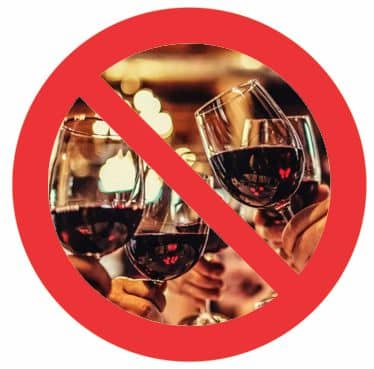Tim James: The prohibitionists are after you
By Tim James, 21 February 2022

1

Government-ordained restrictions on liquor sales under Covid regulations brought out predictable (and not unreasonable) mutterings and shouts about anti-liquor tendencies in the governing ANC. But they’re not the only neo-prohibitionists around: Europe and the USA and probably elsewhere (everywhere!) are full of them. Look even at France, with its unsurpassed wine culture, where the Evin Law has radically restricted liquor advertising (and they don’t even have our shocking levels of foetal alcohol syndrome) to realise that local forces aiming to curtail or even stop alcohol consumption are at the pussy level – at least for now.
You can laugh a bit at the warning on local wine bottles about the dangers of walking in the street when drunk, let alone at the absurd warnings about sulphites (of the tiny percentage of people seriously affected by sulphur, any able to understand the words would surely already know of the dangers). But what if every bottle of wine told you in glaring print that “Alcohol causes cancer”? It’s not going to help your good feelings as you reach for the corkscrew, or going to attract new disciples to our pleasure. Imagine what arch-whingers VinPro would have to say on behalf of wine producers.
Europe narrowly avoided that threat recently. The European Parliament’s Special Committee on Beating Cancer said in a report that the World Health Organization “recognizes that there is no safe level of alcohol consumption”. (Read that carefully.) Effectively, it wants wine-drinking to be treated like cigarette-smoking. If that became the official European position, the consequences for not only European wine would be substantial. The Parliament, however, last week softened this statement, along with other references in the report, before approving it, to say that the WHO “recognizes that the safest level of alcohol consumption is none”. That’s not exactly alcohol-friendly, but crucially different.
If you want to read fuller reports and considerations about neo-prohibitionism in Europe, start as I did with W Blake Grey’s recent article Close shave for European wine industry, and the linked one that preceded it. Grey also points out other important amendments made by the European Parliament to the report. “The major philosophical change”, he says, “is the addition of the word ‘harmful’ in several key places, like this: ‘Harmful alcohol consumption is a risk factor for many different cancers.’ Adding ‘harmful’ implies that there can be alcohol consumption that is ‘not harmful’, and this is an extraordinarily important distinction.”
I’m not here going to try dealing with the large and contested matter of the dangers of alcohol consumption. They undoubtedly exist, even very severely for a part of the drinking population, everywhere in the world. A full and useful national and international response to this would need to have a wider social dimension than one just focusing on the dangers of alcoholism, recognising addiction and abuse as a problem with social as well as physiological origins. I’d guess that prohibition, as attempted in the USA a century ago, is unlikely to return. But hostile governments could make things very difficult and unpleasant for producers of alcoholic drinks, of course including wine. And so for wine-drinkers.
Labelling of products is an obvious tool in the arsenal of legislators. And there’s no doubt that wine (and other alcohol) producers have got away with a lot in terms of minimal statutory information, leaving consumers largely ignorant about what they’re drinking. Generally, all other food and drinks are required to give a complete list of ingredients. I wrote a few years ago about the issue with regard to wine, partly to point out the difficulties legislatiors would have to grapple with, given that many “permitted additives” are removed after performing their function, as well as the addition of naturally occurring substances.
The Alcohol Health Alliance in Britain has recently drawn attention to an important ingredient that certainly could – and I’d agree should – be listed on wine labels: calories and sugar. The AHA seems mostly exercised about sugar, which varies widely across drinks, but alcohol itself contains nearly as many as pure fat, apparently – around seven calories per gram. I’ve seen it authoritatively stated elsewhere that an average bottle of wine contains as many calories as a Big Mac (though is probably more rewarding, I hasten to add). Surely the case is unanswerable for wine to be obliged to list all its ingredients and relevant nutritional information. Interested winelovers are as entitled as fruit-juice drinkers to know what they are electing to ingest.
To end on a morbidly flippant note, I don’t know whether wine is slowly giving me cancer, but all available evidence shows that it is helping to inexorably stretch my waistline.
- Tim James is one of South Africa’s leading wine commentators, contributing to various local and international wine publications. He is a taster (and associate editor) for Platter’s. His book Wines of South Africa – Tradition and Revolution appeared in 2013.







Hennie | 21 February 2022
Tim, the paragraph of calories per bottle refers. I am currently on a 100 day sabbatical from drinking wine (alcohol really, but I only really drink wine ever). It is painful, to say the least. There is a positive however.
The weight is literally falling off of me. So I would not be at all surprised if the calorie count is as high as stated.
To me it would add a lot of value of the breakdown is added to the labels of wine like they do for food.